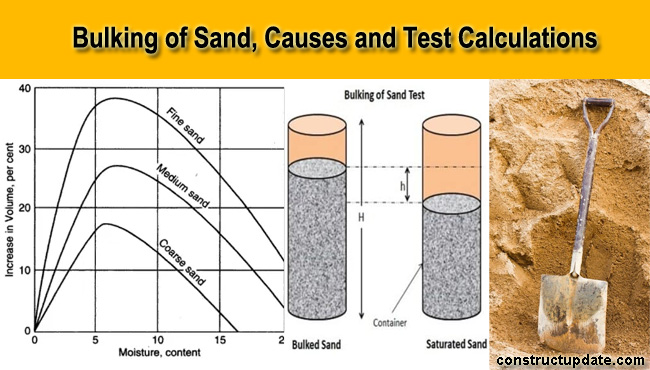Bulking of Sand | Sand Bulkage Causes | Sand Bulkage Test
What is Bulkage of Sand?
Sand undergoes layer formation with an increase in volume due to contact with atmospheric moisture. This is known as Bulkage of sand / Bulkage of aggregate or sand bulking.
Causes of Bulking of Sand:
Following factors might be responsible for sand bulkage:
- Moisture content in the atmosphere.
- Small-sized sand particles.
Impacts of Bulkage of Sand:
Concrete loses strength as a result of an increased volume of sand due to contact with moisture in the atmosphere. With the increase in workability strength of the concrete gradually decreases.
Few Points on Bulkage of Sand or Bulking sand:
- The amount of moisture content of sand brought on to a building site or other sites of work will increase, if filled loosely into a container, to occupy a greater volume than it would occupy in a drier state.
- If the measurement of sand is done by loose volume, it is necessary to increase the measured volume of the sand, in such an order that the amount of sand put into the concrete should be the amount intended for the nominal mix (based on dry sand) used.
- It is necessary to increase the volume of sand by the ‘percentage’ bulking. A rough approximation of correction is made. A correction of the right order can be determined easily and should be applied to keep the uniformity of concrete.
Test Methods for Bulking of Sand/Aggregate:
As per IS Code 2386 part 3 Page 14 Cl 4.3, two methods for testing the bulkage of sand/aggregate are:
• Laboratory Test for Bulkage of Sand/Aggregate
• Site Test for Bulkage of Sand/Aggregate
Both test methods depend on the fact that the volume of inundated sand is same as the volume of dry sand.
Laboratory Test for Bulkage of Sand/Aggregate:
Apparatus Required:
- Measuring Cylinder.
- Sample Sand.
Procedure:
A sufficient quantity of the sand is kept loosely in a container until it is about 2/3rd full. The top of the sand is leveled off and a steel rule is vertically pushed down through the sand in the middle to the bottom, measuring the height.

The sand is then emptied out of the container into another container without losing any bit of it. The first container is half-filled with water. About half the sand is put back and ridded with a steel rod, about 6 mm in diameter, so that its volume is reduced to a minimum. Then the remainder of the sand is added and ridded in the same way. The upper surface of the inundated sand is smoothened and leveled, while its depth at the middle is measured with the steel rule.
Assuming the height =h cm.
The percentage of bulking of the sand due to moisture can be calculated from the given formula.
2. Site Test for Bulkage of Sand/Aggregate:
Apparatus Required:
- Measuring Cylinder
- Sample sand
Procedure:
In a 250-ml measuring cylinder, the damp sand is poured (consolidated by shaking) until it reaches the 200-ml mark. The sand needs a well stir and then the cylinder is filled with water (the water shall be sufficient to submerge the sand completely). It will be observed that the sand surface is now below its original level.
Assuming the surface to be at mark y ml. The percentage of bulking of the sand due to moisture shall be calculated from the given formula.
Above all point from IS Code 2386 part 3 Page 14 Cl 4.3.3.
Results Reporting:
The bulking of the sand percentage is reported to the nearest whole number. From IS Code 2386 part 3 Page 14 Cl 4.3.4.





